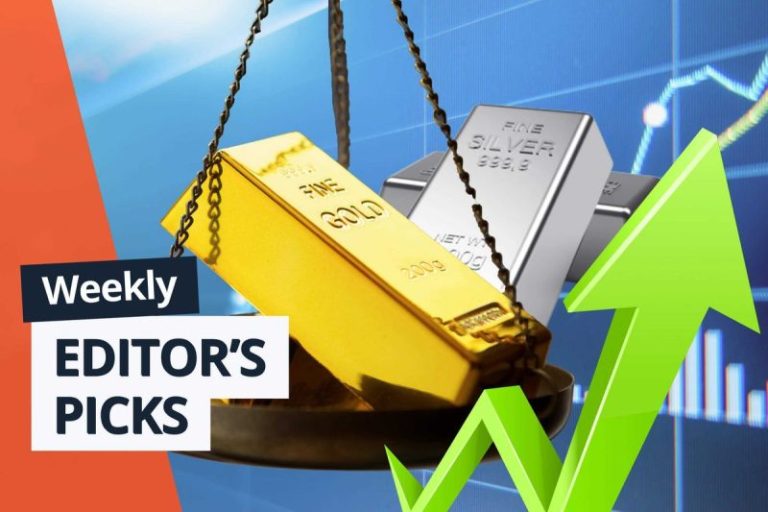It’s been yet another historic week for gold, as well as silver.
Gold broke through US$4,000 per ounce midway through the period, entering never-before-seen territory as the US government shutdown continued into a second week.
Silver’s milestone was perhaps even more impressive. The white metal pushed through the elusive US$50 per ounce mark and continued on past US$51, marking a new record.
What’s behind its takeoff? Silver is known for its duality as both a precious and industrial metal, and experts have emphasized that it’s a mix of factors moving silver right now. It’s catching up to gold, which itself is supported by global geopolitical uncertainty and concerns about fiat currencies, and it’s also got its own specific elements at play.
Backwardation, which happens when a commodity’s spot price is higher than its futures price, has been a frequent topic of discussion, and prior to silver’s move past US$50, precious metals analyst Ted Butler gave a rundown of the implications for silver.
Here’s what he said:
‘Normally, (backwardation) results in an overwhelming demand for physical. That could take the form of SLV investors standing for delivery, whether that be the the industrial players, who are notoriously resolute, or even billionaire whales from India.
‘But in that event, which is already playing out, by the way, silver prices and premiums will continue to increase, maybe even dramatically, as the news of insufficient physical silver transmits itself through the market.’
As those who follow precious metals will know, silver has only been at the US$50 level twice before — the first time was in 1980, when the Hunt brothers tried to corner the market, and the second instance was over a decade ago in 2011. Both of those moves were brief, and investors are understandably wondering if this time is different for silver.
It’s impossible for anyone to say for sure, but I’ve been hearing market watchers highlight the gold-silver ratio as a way to gauge the outlook for silver.
Ahead of silver’s US$50 landmark, David Morgan of the Morgan Report explained that the ratio shows silver still has room to rise. Here’s what he said:
‘We’re still in the 80s for the gold-silver ratio, which is historically high. And until we get to 70, I’m not going to be particularly happy. And off of today’s gold price, a 71 ratio would be like … US$55 silver, and that would be over that US$50 mark.’
Morgan also talked about the psychological impact of US$50 silver, saying that it could prompt algorithmic traders and institutions to enter the sector:
‘You’ll see algorithms come in and start trading silver, and you’ll probably see institutions come in, because they know that it’s a small market, and they can move the market with a buy order, if it’s significant enough.
How high can gold and silver prices go?
Taking a step back to look at the precious metals rally as a whole, I want to reiterate that the experts I’ve been hearing from don’t think this is the end of the bull market.
While many have emphasized that a correction would be healthy for gold and silver, they think the current cycle is still in progress and is likely to end with much higher prices.
Here’s Lynette Zang of Zang Enterprises on what could be coming:
‘If you go back to the beginning of the year, what you actually see is that while everything is going up, the spot contracts on gold and silver, and particularly silver, are much stronger and more powerful than those prices that we’re seeing in the stock market, or even in the Bitcoin market, in the crypto markets.
‘Gold and silver are handily outperforming, and that’s telling us (why) the central banks have been accumulating more gold than they ever have since they began tracking — because they know what they’re doing to destroy the currencies.’
It’s also worth noting that it’s not just people in the gold and silver space that are optimistic.
Precious metals are increasingly making news headlines, and more and more mainstream authorities are touting their protective benefits.
Just this week, American billionaire Ray Dalio of Bridgewater Associates suggested that investors allocate as much as 15 percent of their portfolios to gold. He compared the current environment to the 1970s, a time of high inflation and debt.
Dalio’s opinion is similar to that of DoubleLine Capital’s Jeffrey Gundlach, who recently said a 25 percent weighting toward gold wouldn’t be excessive.
Platinum and palladium take off
Gold and silver may be attracting the most attention, but platinum and palladium are also on the move.
Platinum, which spent years trading at rangebound levels, has broken out in 2025, and is currently above US$1,600 per ounce, a price not seen since 2013.
Palladium, whose price has been subdued since seeing several spikes between about 2020 and 2022, was also on the move this week, approaching US$1,500 per ounce.
While these precious metals are similar, it’s mostly platinum that’s being talked about as a potential opportunity for investors. Historically it’s often been priced higher than gold, and some see the two finding parity again in the future.
Securities Disclosure: I, Charlotte McLeod, hold no direct investment interest in any company mentioned in this article.



